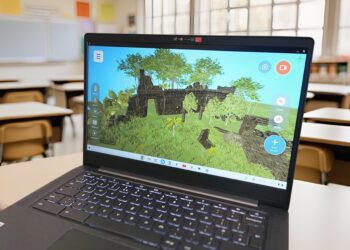Many of the most valuable jobs of tomorrow depend on the STEM education happening in today’s classrooms.
The US Bureau of Labor and Statistics projects that by 2020, there will be 1.4 million IT jobs available but only 400,000 computer science graduates with the required skills to fill the positions. Companies continue to report their STEM jobs aren’t being filled, and HR departments are not finding applicants with the necessary skills for success. STEM Connector data shows there will soon be 3 million vacant jobs because students entering the workforce are lacking STEM skills. The good news is that STEM education initiatives are on the rise across the country to meet this growing demand in the workforce.
To satisfy this appetite for STEM, educators are feeling the pressure to make curriculum changes, but many are not sure how to begin. School districts respond to this pressure by providing courses for gifted students and STEM-focused afterschool clubs. However, this selective approach is failing to provide adequate STEM education experiences for all PreK-12 students.
Timing is crucial for sparking the curiosity necessary for placing students on the path toward a STEM career. By the time students reach high school, they have already developed strong perceptions about themselves and future STEM careers, leaving educators playing catch-up.
Find ready-to-use STEM activities and resources in your daily learning platform!
Spreading STEM Education Far and Wide
The idea that STEM is only for the most gifted students on track for graduate degrees is now a falsehood. Roughly 35 percent of the 8.6 million STEM jobs needed nationwide will require sub-baccalaureate degrees by the year 2020. Apple recently shared that 28 percent of their workforce does not have a 4-year degree. Armed with this data, what is the appropriate path forward for educators to ensure the next generation possesses a proper amount of STEM knowledge?
Educating all students in STEM practices will level the playing field and provide pathways to future success for all no matter your zip-code, skin color, cultural background, or gender.
Something needs to change, but it is unfair to expect educators to institute foundational changes without extensive support. A study conducted by Horizon Research could light the way for districts looking to make changes.
In the NSF Urban Systemic Initiative, $1 billion was dedicated across 10 years to encourage middle and high school math and science teachers to conduct more hands-on inquiry and use technology. After 10 years, Horizon researchers found that teachers needed 80 hours of professional development (PD) focused on a defined set of strategies to change their practice and 160 hours of PD focused on a defined set of strategies to change the culture.
As a result of this research, we now have a better understanding of what it will take to truly change the culture and practices in a school. The onus will not fall only on teachers, but administrators, leaders, communities, and the broader education community. Professional learning will be the key to this transformation. Horizon researchers further determined the most effective PL was not just direct training, but a combination of in-person training combined with job-embedded coaching.
The beauty of STEM education in all PreK-12 classes is that all students love to find solutions for real-world problems. Asking students to create solutions to these problems respects their unique thinking and invites them to use their abilities to generate innovations that can make the world a better place.
When students and teachers develop 21st century skills like collaboration, critical thinking, and creativity, all types of learners become engaged. Asking students to work together to find solutions in authentic situations further develops their communication skills and character, both vital to joining the STEM workforce of the future.
How STEM for All Students Can Make an Impact
While I was serving as Director of PreK-12 STEM education for the 145,000 students in the Charlotte Mecklenburg School District, my colleagues and I began STEM work with students in our struggling Title 1 schools. Many of these students were several years below grade level in reading and math. We discovered, however, that these economically disadvantaged students were excellent problem solvers, constantly engaged in repurposing items to entertain themselves at home and were accustomed to outside-the-box thinking.
By providing professional learning to teachers to support hands-on inquiry using real-world problems, we engaged students who were not typically excited to be in school. Though we began the process struggling to reach students who had discipline problems, were below grade level in reading and math, and did not come from families that had graduated from college, we soon witnessed rapid changes.
After one year of providing STEM teaching and learning, our state test data indicated the average student experienced up to two years of growth in classes utilizing STEM practices, while special education and English Language Learners were experiencing four to five years of growth. Teachers experienced more job satisfaction and the attrition rates at these Title 1 schools decreased swiftly as a result of the support and success.
Following the success of the first year of STEM with Charlotte-Mecklenburg Title 1 schools, other schools in the district were eager to get involved. After three years, our fifth and eighth grade science test scores improved by 44 points, while the state scores increased by six points. Our math teachers dipped their toes in the STEM waters and added a short digital asset to their curriculum to make math relevant to students. This simple addition, coupled with a few non-threatening STEM practices integrated into their lessons, improved third through eighth grade math scores by 35 points, while the state scores increased by seven points.
When we began this work, there was a 37-point gap between economically disadvantaged students and their peers. After three years of STEM education, the gap decreased to seven points. It’s rare for a school district to reduce the achievement gap so significantly, and so quickly. These results speak for themselves.
As educators, it is our moral obligation to ensure that all of our students have the opportunity to develop the skills necessary to become part of the STEM ecosystem of today and tomorrow.
As Yoda says, “Do or do not; there is no try.”
About the Author
Dr. Cindy Moss is currently the Senior Director of Global STEM Initiatives for Discovery Education, and travels the world helping companies, nonprofits, Ministries of Education and school districts understand the importance of STEM education and how to implement it successfully. Previously Dr. Moss served 10 years as the PreK-12 Director of STEM for the 145,000 students and 10,000 students in the Charlotte Mecklenburg School system.






